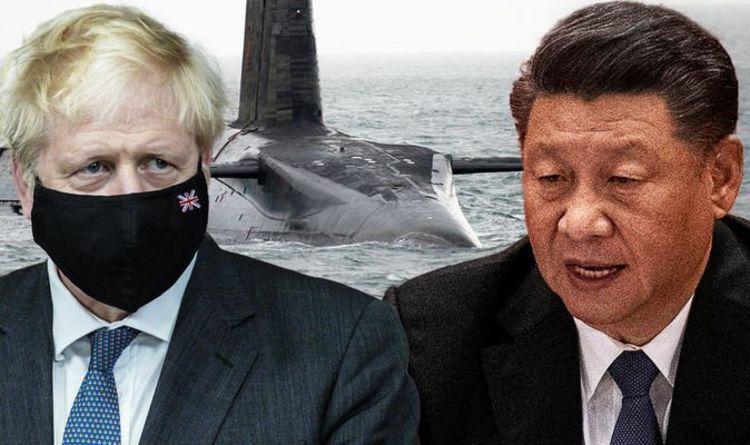France slammed over Australia submarine row by Chris Smith
We use your sign-up to provide content in ways you’ve consented to and to improve our understanding of you. This may include adverts from us and 3rd parties based on our understanding. You can unsubscribe at any time. More info
The UK, USA and Australia agreed a new military submarine partnership over the weekend, upending its multibillion-dollar deal with France. Australia will now pursue nuclear-powered submarines over conventional diesel-electric subs. The abrupt decision to scrap the France deal stoked geopolitical tensions with France and other EU countries.
Submarines can be either diesel-electric or nuclear-powered – with either type able to hold nuclear warheads.
Diesel-electric vessels use electric motors charged by diesel engines to move – requiring air and fuel to operate.
These submarines need to resurface more frequently and therefore are easier to detect.
Nuclear-powered submarines run off steam generated by an onboard nuclear reactor which turns the turbines meaning they can remain submerged for years, limiting their detection.
These machines tend to be larger, but require more expensive infrastructure and maintenance.
There are currently six countries with nuclear-powered submarines and, under the new Aukus deal, the US and UK will enable Australia to become the seventh.
The first nuclear-powered submarine was built by the US in 1954.
The 97m vessel was named USS Nautilus and is now one of the US’s 68-strong fleet of nuclear-powered subs, of which 14 are strategic nuclear-powered ballistic missile submarines (SSBNs).


The Soviet Union, which consisted of 15 soviet republics from 1922 to 1991, launched its first nuclear-powered submarine in 1957.
This submarine was called K-3 Leninsky Komsomol and after the collapse of the Soviet Union, Russia inherited the bulk of the USSR’s submarine fleet and undersea technology.
Russia which now includes 36 nuclear-powered vessels and 21 other propulsion method machines.
The nation’s fleet is smaller than that owned by America, but Russia has a bigger bag of tricks.


China is another strong military submarine power – first building a nuclear-powered submarine in 1974.
Beijing has at least 60 operational submarines, 10 of which are nuclear-powered and half of those are SSBNs.
China’s submarine fleet is currently on track to surpass the USA’s by 2030.
The US is projected to have 66 submarines of all types by that time, compared to a projection of 66 for China.
China’s ongoing naval expansion has been the largest since the Second World War and according to a Congressional Research Service report published in March 2020.
DON’T MISS
China panics NATO military chiefs with investment in EU ports [INSIGHT]
Germany signs space deal with Australia hours before backing Macron [EXPLAINER]
Archbishop tells PM: Restore full military benefit for war widows [ANALYSIS]

Britain, France and India are the remaining countries which currently have nuclear-powered military submarines.
The UK has 11 nuclear-powered submarines, of which four are SSBNs.
The Royal Navy ordered five submarines in 1900 and the following year its first submarine, Holland 1, was launched.
France has 10 nuclear-powered vessels, while India has one nuclear-powered submarine and 16 other propulsion machines.

The Aukus deal, forced to counter the emerging threat of China, will see the UK, USA and Australia share technologies to build at least eight submarines.
The submarines will be built in Adelaide, making Australia the seventh country in the world to have submarines propelled by nuclear reactors.
Australia said preparations for the deal would take 18 months and therefore the project largely relies on the UK and US expertise to ensure it is delivered at the earliest possible date.
In addition to challenging China’s rapid expansion of military submarines, North Korea is another threat the Aukus deal will help arm against.
North Korea operates one of the world’s largest submarine fleets with 71 submarines, of which one is a diesel-electric ballistic missile submarine (SSB), 20 conventionally (diesel-electric) powered attack submarines (SSKs), 40 conventionally-powered submarines with dedicated launch tubes with guided missiles (SSCs) and 10 midget submarines (SSWs).
The nation criticised the Aukus deal, describing it as “extremely undesirable and dangerous”.
Nuclear-powered submarines are not the only vessels owned around the world – many nations have diesel-electric submarines which tend to be smaller and cheaper to maintain.
According to the Military Report 2021, a reference tool published each year outlining the capabilities of armed forces around the globe and published in February 2021, found these countries have the following number of diesel-electric attack submarines (SSKs):
- China: 46 SSKs
- Japan: 22 SSKs
- The Democratic People’s Republic of Korea: 22 SSKs
- Russia: 21 SSKs
- The Republic of Korea: 18 SSKs
- India: 14 SSKs
- Turkey: 12 SSKs
- Greece: 11 SSKs
- Italy: Eight SSKs
- Egypt: Seven SSKs
- Germany: Six SSKs
- Australia: Six SSKs
- Vietnam: Six SSKs
- Algeria: Six SSKs
- Peru: Six SSKs
- Norway: Six SSKs
- Brazil: Five SSKs
- Israel: Five SSKs
- Sweden: Five SSKs
- Pakistan: Five SSKs
- Chile: Four SSKs
- The Netherlands: Four SSKs
- Canada: Four SSKs
- Singapore: Four SSKs
- Taiwan: Four SSKs
- Indonesia: Four SSKs
- Poland: Three SSKs
- Malaysia: Two SSKs
- Portugal: Two SSKs
- Spain: Two SSKs
- Australia: Two SSKs
- South Africa: Two SSKs
- Colombia: Two SSKs
- Ecuador: Two SSKs
- Venezuela: One SSK
- Cuba: One SSK
- Thailand: One SSK
- Myanmar: One SSK
- Iran: One SSK.
Source: Read Full Article





